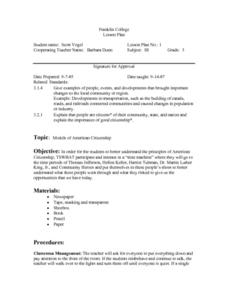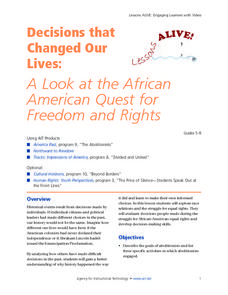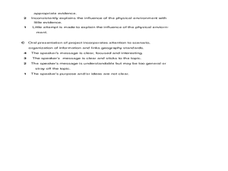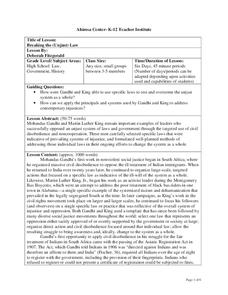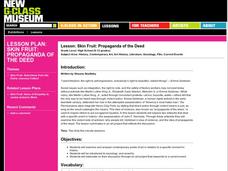Curated OER
Introduction to Music of the Civil Rights Era
Pupils summarize the major events of the Civil Rights Movement. They examine leaders such as Martin Luther King, Jr. and Malcolm X and what they did for the movement. They also listen to music from the Civil Rights Era and their functions.
Curated OER
Civics: The Rule of Law
Students examine key concepts pertaining to the rule of law. They explore how Civil Rights leaders such as Martin Luther King, Jr. used it to oppose discrimination practices. They examine Supreme Court decisions demonstrating the...
Curated OER
Models of American Citizenship
Third graders investigate the concept of American citizenship by pretending to time travel. They travel back in time to visit the eras of Thomas Jefferson, Hellen Keller, Harriet Tubman, Dr. Martin Luther King, Jr., and community heroes....
Curated OER
MLK Eggs
Students examine brown and white eggs to represent how people are all the same on the inside. In this character education instructional activity, students view two kinds of eggs and examine them closely to determine if one egg is the...
Curated OER
Attracting an Audience With Purpose
Students discuss the attributes of a good speech and a bad speech, and listen to Martin Luther King Jr.'s speech, I Have A Dream. They rewrite a speech, directing it to a different audience than it was intended for.
Curated OER
"We few, we happy few": Motivational Speech in Henry V
Students explore how to write and deliver a motivational speech by examining King Henry's in "Saint Crispin's Day".
Curated OER
Reaching the Clouds for Equality
Learners listen to Martin Luther King's "I Have a Dream" speech. They create their own cloud and write a dream they have for the world inside. They write journal entries on how to treat others fairly.
Curated OER
The African-American Experience During the Vietnam Conflict
Students examine the experiences of African-Americans in the Vietnam War. They illustrate their experiences showing how these events related to the Civil Rights movement. They compare and contrast the views of sailors and officers aboard...
Curated OER
Roll Of Thunder, Hear My Cry
Middle schoolers read the novel "Roll of Thunder, Hear My Cry". Using the text, they gather information on how and why the Civil Rights Movement began. They use excerpts from Martin Luther King Jr's speeches to discuss the issue of...
Curated OER
Decisions That Changed Our Lives: A Look At the African American Quest for Freedom and Rights
Students are introduced to the goals of abolitionists throughout history. In groups, they use the internet to discover the purpose of the Underground Railroad and why there were bus boycotts in the 1960s. They compare and contrast the...
Curated OER
An Introduction to the Season for Nonviolence
Fourth graders create a Venn diagram and a cause and effect graphic organizer on Gandhi and King. In this non violence lesson plan, 4th graders compare the two non violent leaders and discuss and articulate non violent protests and write...
Curated OER
Growth in A City Neighborhood
Students take the "role" of city planner. They overlay a map of one area of the city in the past, present, and projected future project. Students discuss reasons for selecting the special features of the area. The activity refers...
Curated OER
Breaking the Unjust Law
Students consider the concept of civil disobedience. In this lesson on changing unjust laws, students use primary sources to understand how Gandhi and King changed the law. Students will then list laws that they feel are unjust and plan...
Curated OER
Understanding Effectiveness
Students investigate the work of animal welfare advocates. In this advocacy lesson plan, students examine advocacy strategies and investigate their effectiveness as they analyze King's "I Have a Dream" speech. Students apply the advocacy...
Curated OER
Lesson: Skin Fruit: Propaganda of the Deed
Art can express acts of injustice and move society to action. Upper graders analyze contemporary art relating to specific moments in history. They discuss propaganda, anarchy, sociology, and violence as activism. After researching and...
Curated OER
Civil Disobedience from Antigone to Hunger Games
Study the concepts and practice of civil disobedience through fiction and nonfiction texts.
Curated OER
Debating the Issues: Ralph Bunche and Civil Rights
Synthesizing information from a PBS documentary Ralph Bunche: An American Odyssey, its companion website, and several other resources (links to which are provided), high schoolers evaluate whether Bunche did all he could to advance the...
Curated OER
Determining Author's Point of View: The Sneeches
Determine the author's point of view in a text. Young readers read Dr. Seuss' The Sneeches and identify the author's purpose in the story. They identify persuasive techniques in writing, asking and answering questions to better...
Curated OER
I Can Be Whomever I Wish
Famous people who have overcome obstacles are the focus of this language arts and social studies instructional activity. Pupils are introduced to the concept that they have the ability to overcome obstacles in life. They read selections...
Curated OER
How Rosa Parks Sparked Change
Rosa Parks proves that one person, no matter their race, can make a difference.
Advocates for Human Rights
Mock Immigration Court
As part of a unit study of immigration, class members participate in a mock Immigration Court activity in which they argue four cases before an immigration judge.
Stanford University
Observing Human Rights Day
How much intervention is appropriate for America to take in cases of human rights violations? Class members ponder a question that has lingered since the birth of America with a series of primary sources that reflect the degree to which...
Curated OER
Recognizing the Main Idea
Understanding that paragraphs have a main idea expressed in a topic sentence, followed by supporting details in the subsequent sentences is the focus of this presentation. Students practice by reading short paragraphs in 10 slides, and...
Stanford University
Ruby Bridges
A two-part lesson features Civil Rights hero, Ruby Bridges. Part one focuses on the heroic actions of Ruby Bridges then challenges scholars to complete a Venn diagram in order to compare themselves to her. Part two begins with a...




